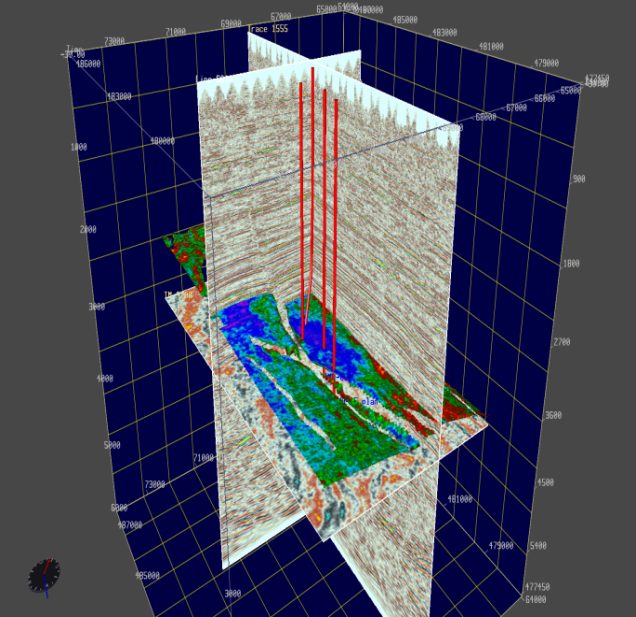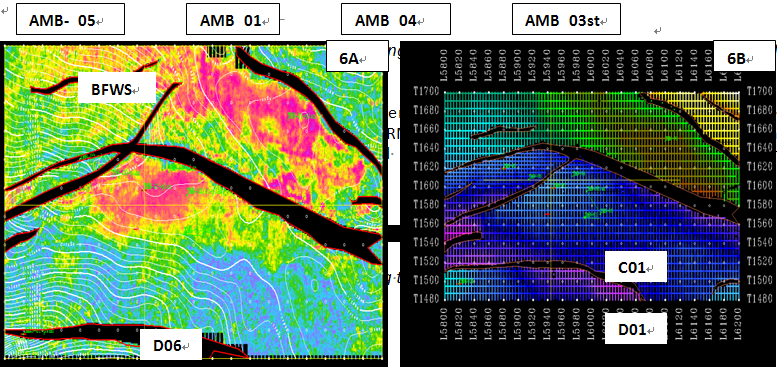-
Paper Information
- Previous Paper
- Paper Submission
-
Journal Information
- About This Journal
- Editorial Board
- Current Issue
- Archive
- Author Guidelines
- Contact Us
Geosciences
p-ISSN: 2163-1697 e-ISSN: 2163-1719
2012; 2(3): 60-65
doi: 10.5923/j.geo.20120203.04
The Integrated Seismic Reservoir Characterization (ISRC), Study in Amboy Field of Niger Delta Oil Field – Nigeria
Odoh B. I 1, Onyeji Johnbosco 2, Utom A. U 2
1Department of Geological Sciences, Nnamdi Azikiwe University, Awka, Anambra State, Nigeria
2Onyeji, Johnbosco, Ebute-Metta, Lagos, P. O. Box 1369, Nigeria
Correspondence to: Utom A. U , Onyeji, Johnbosco, Ebute-Metta, Lagos, P. O. Box 1369, Nigeria.
| Email: |  |
Copyright © 2012 Scientific & Academic Publishing. All Rights Reserved.
ISRC procedures were used to extrapolate petrophysical parameters away from the existing wells to other parts of the Amboy field. Two formations (Benin and Agbada Formations) are underlain in the study area. The massive Benin Sands outcrop at the surface with the base of fresh water sands at -7440ft., and the Agbada Formation was down to the total depth (-12975ft,). Four reservoir sand packages (C01, D01, D06 and D07) were mapped within the Agbada reservoir unit, but C01, D01 and D07 formed reservoirs of interest. The three sands (C01, D01 and D07) are of Miocene age, and formed a 3-way dip structural closure trapped against the up-thrown side of the NE - SW antithetic fault. The sands are relatively clean and well developed. Reservoir characterization specifics show; - porosity = 24 - 29.8%; hydrocarbon saturation. = 69 - 89%; permeability = 379 – 613 md and oil gravity ranges from 23 to 35 API (Normal Oil). The structural style of this area consists of growth faulting alongside other crestal relief faults. The D07 sand package is the largest reservoir observed in Amboy Field. Also, an increase in porosity, net/gross and hydrocarbon saturation were observed to lower the reservoir acoustic impedance of D07 sand package compared to the shallow reservoir sands.
Keywords: Reservoir Characterization, Petrophysical Properties, Structural Map, Porosity, Permeability
Article Outline
1. Introduction
- The Amboy field is one of the Niger Delta Oil fields, located on the north- eastern onshore part of the Nigerian’s Oil concessions. The field was discovered in April 1974 by AMB_1X exploratory well. The Field is down thrown to the E-W trending structure building fault. Hydrocarbon trapping mechanism is a 3-way up-dip structural closure against NE-SW striking antithetic fault. The Niger Delta area of Nigeria is situated in the Gulf of Guinea (Figure 1) and extends throughout the Niger Delta Province as defined by Klett et al. (1997). Doust and Omatsola (1990) noted that from the Eocene to the present, the delta has prograded southwestwards, forming depobelts of most active portion of each stage of the delta’ development. According to Kulke (1995), the Niger Delta contains only one identified petroleum system referred to as the Tertiary Niger Delta (Akata-Agbada) petroleum system. The maximum extent of the petroleum system coincides with the boundaries of the province (Opafunso, 2007) while the maximum extent of the system is defined by the area extent of the fields that contain known resources of 34.5 Billion Barrel of Oil (BBO) and 93.8 Trillion Cubic Feet of Gas Barrels of Oil (TCFG) (Petroconsultants, 1996b).
2. Methodology
- Migrated 3-D seismic data were used to delineate geophysical structure evidenced by continuous lateral reflection events. Surface seismic data with high-lateral resolution, but of low vertical- resolution, provided acoustic impedance data. The acoustic impedance and seismic wavelet were estimated from wireline data acquired in the existing well. Amplitude variation of the same reflections was interpreted in terms of lateral and vertical changes in petrophysical properties and lithologies for reservoir characterization. Well log data with higher-vertical resolution with respect to that of seismic data, but of very shallow lateral penetration provided petrophysical parameters in the rock formations adjacent to the borehole. The ISRC method provides processing steps which bring the two sets of measurements to common physical base and to a common time/depth domain. The first step involved delineating the reservoir sands and saturating fluids in terms of standard petrophysical parameters (well log interpretation). This step aided in the interpretation of vertical - resolution of the field. The interpretation and correlation of different lithologies from the well logs were carefully carried out, noting and picking areas of sand and shale development from gamma ray and resistivity logs. The depth boundaries of such compartments were transformed into time domain to provide reference markers to the seismic data. Subsequently, seismic time horizons were tied to the markers and laterally followed across the complete seismic cube to reconstruct the local structural traps and stratigraphic embedding. Petrophysical parameters were also determined from individual logs. The values obtained were slotted into the appropriate Archie’s equation to obtain the required petrophysical data, using computer logic. Fluid types and contacts were determined based on resistivity and porosity logs (Tables 1 - 3). The second step involved the application of seismic, structural and stratigraphic interpretation techniques, after tying the log markers (formation tops) to the seismic time section. This method involves, the identification of prominent features such as major faults (i.e., fault interpretation), and the delineation / mapping of continuous seismic reflection events (i.e. horizon interpretation). To integrate the two sets of the measurements, velocity model were built with a combination of check shots of the control well and stacking velocity of the area for the conversion of Time-Depth using TDQ software. The model was used to generate the depth structure map of the interpreted horizons, contoured at 50ft interval using ZMAP application.
2.1. Data Set
- The Amboy oilfield where the data set for the study was collected is owned and managed by Chevron Nigeria Limited. The precise location was not disclosed in line with current practices by petroleum industries in Nigeria. Nonetheless, the graphic description of the data set used for the study reported in this paper is shown in Figure 2.
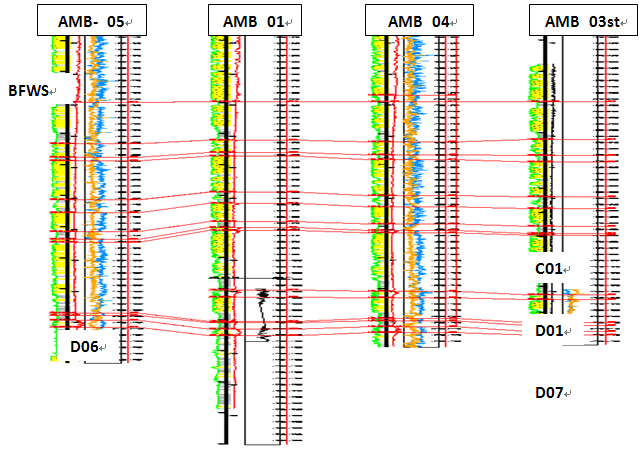 | Figure 4. Correlated Stratigraphic cross-section showing formation tops and bases, reservoir sands and fault cut in well 05 (D01) |
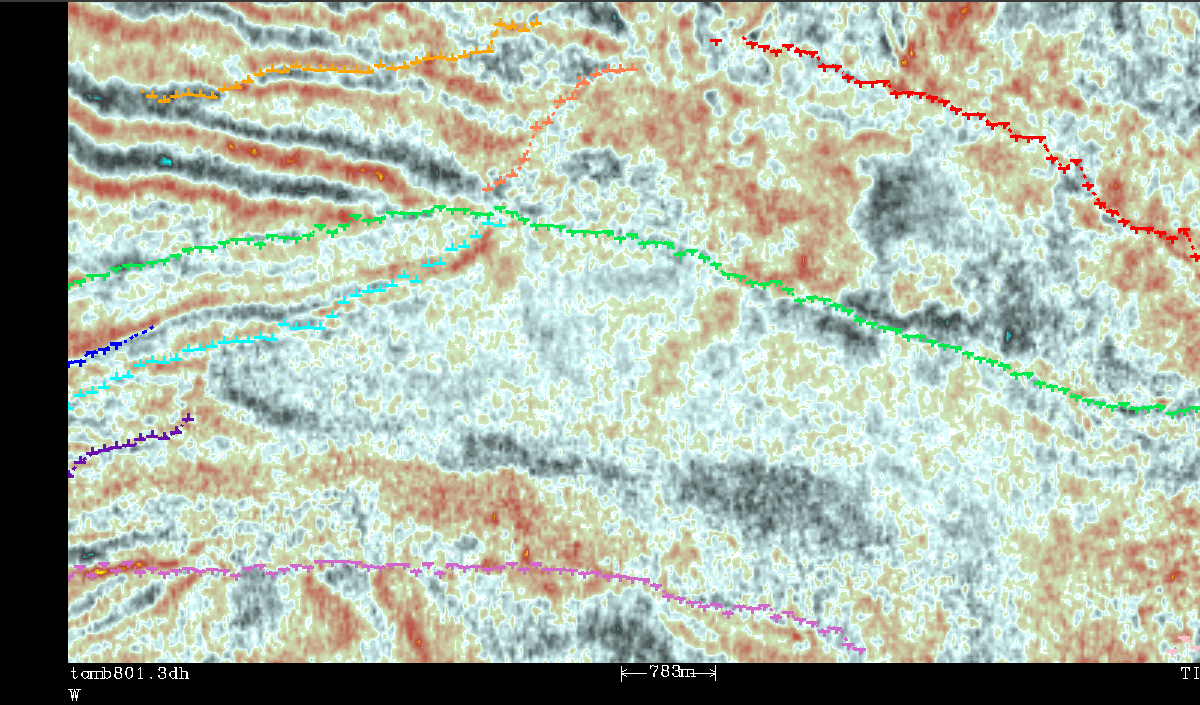 | Figure 5. Seismic time slice sampled at 2.5 ms showing the embedding structure in the study area |
3. Results and Discussion
3.1. Stratigraphy
- Lithostratigraphic interpretation of the Amboy Field was done by the use of well logs; correlation of sandstone and shale bodies; and construction of subsurface cross-sections. Two lithostratigraphic units; - Benin and Agbada Formations were recognized in the wells studied (AMB_05, 01, 04, 03st). From the analysis of the well logs, the Benin Formation was recognized by low gamma ray count and high resisitivity reading of fresh water. The massive Benin Sands were encountered at the surface, with the base of fresh water sands (BFWS) at about -7440ft. It was observed that the upper part of the formation is sandier than the lower part. The base of this formation was determined in all the wells by the first remarkable changes in the well logs responses. These changes include; increase in the number of intervals with high gamma ray readings and high resistivity readings; the sand on the top of the first thick shale bed interval was identified as the BFWS based on the above mentioned changes (Figure 4). The sands were unconsolidated, fine to medium grained with interbedded clay to shale bed and lignite beds. The Benin Formation has been interpreted to have been deposited in shallow water depositional environment (Short and Stauble, 1967; Ekweozor and Daukoru, 1984). The base of Benin Formation was determined in wells 05, 01, 04 and 03 as -7440ft. Agbada Formation was down to the total depth. An increase in the alternations of sandstone and shale were recognized on the formation; suggesting a decrease in the sand/shale ratio; and mark the appearance of the paralic Agbada Formation. Also, at the upper part of the Agbada Formation, distinctive shaly bodies were identified below the BFWS (Figure 4). These shaly bodies were delineated by peculiar log signatures and they are present in all the wells. The shale was correlated across the entire field from E-W. The thickness of the shale ranges from 64 to 96 ft. This transitional paralic interval represents part of the Agbada Formation; and a transition from continental Benin Formation to Agbada Formation. Four reservoirs sands (C01, D01, D06 and D07) were also recognized (Table 1). The presence of interbedded shales provided the top seals against vertical migration of hydrocarbon. Hydrocarbon bearing sands are mainly found within the Miocene package in the Amboy field.
3.2. Structure
- Amboy Field is a simple faulted anticlinal structure. The structural style in this area consists of growth faulting alongside with other crustal relief faults (Figures 3 and 5). The synsedimentary growth faults activated at the delta front retards the advancement of the sandy Benin Formation. The down thrown part becomes the new focus of Agbada paralic facies deposition until subsidence stabilizes; by then a maximum thickness of Agbada Formation has been deposited (Ekweozor and Daukoru, 1984). The prominent structural features recognized in this field include: rollover anticlinal ridges (C01, D01 and D07) and the associated synclinal features (Figures 7A – 7C). C01/AMB_04; - Well developed hydrocarbon reservoir with clean sand, coarsing upwards; It has good correlative and lateral continuity across the field (Figure 7A). D01/AMB_04: - Lacks good correlative and lateral continuity across the field, since it is faulted out in AMB_05; well-developed reservoir with clean sand and some shaly matrix, fairly consolidated and the sand is fine to medium grained (Figure 7B). D07/AMB_05: - Deposited in a wave dominated deltaic front marine environment. It has very good correlative and continuity across the field. It is the largest known reservoir in the field (Figure 7C); well developed hydrocarbon reservoir with clean sand at the upper part and some shale matrix intercalations at the lower interval. The sand is fine to medium grained and fairly to poorly consolidated. The three sands (C01, D01 and D07), all lie within the Miocene and are all 3-way up-dip structural closure trapped against the up thrown side of the NE-SW trending antithetic fault.
|
|
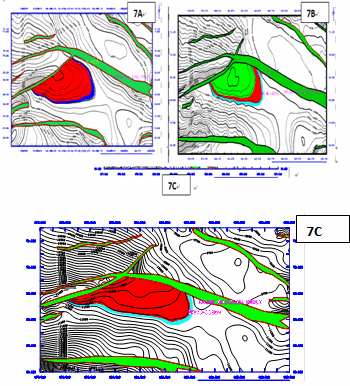 | Figure 7. A: - Depth Structure map of Yellow_Horizon (near C01 top) showing C01 reservoir sand with its fluid contents & contacts; Oil (red) and Water (blue). 7B:- Depth Structure map of Pink_Horizon (near D01 top) showing D01 reservoir sand with its fluid contents &contacts; gas (top), oil (middle) and Water (base). 7C:- Depth Structure map of Green _sand_Horizon (near D07 top) showing D07 reservoir sand with its fluid contents & contacts; oil (middle) and Water (base) |
3.3. Reservoir Characteristics
- Three out of the four potential reservoirs recognized in the field were an area of interest; among them are C01_sand, D01_sand, and D07_sand. Wireline petrophysical parameters were laterally extrapolated from the existing control wells (AMB_ 05, 04, 03st) to other parts of the field using migrated 3-D seismic data. This process provides a very good result on reservoir properties necessary for reservoir characterizations. The porosities of the reservoirs range from 25-29.8%, Vertical and slight lateral variations were observed in the porosity values of the field (Table 2). This was suggested to be as a result of sedimentation processes and the age of the sediments. Hydrocarbon saturation values changes slightly from E-W and decreases down the depth; depicting that at greater depth hydrocarbon saturations declines (Tables 3). Also, increase in porosity, net/gross and hydrocarbon saturation were observed to lower the reservoir acoustic impedance of D07 reservoir sand in well AMB_05 compared to the shallow reservoir sands tested by the same well; this could be attributed to the lithology. Production depth varies from 9516 ft to 11200 ft in the field. C01 / AMB_04: - Gross thickness = 36 ft; Net thickness = 27 -32 ft; Average porosity = 29.8 %; Average Hydrocarbon Saturation = 82 %; Average Permeability = 379md; Oil Gravity = 23 API; 3 Reserves = 4.6 Million Barrel of Oil. D01 / AMB_04: - Gross thickness = 90ft; Net thickness = 32-74 ft; Average porosity = 26.1%; Average Hydrocarbon Saturation. Sat. – 69.2%; Average Permeability = 232 md; Oil Gravity = 33 API; 3 Reserves = 3.9 Million Barrels of Oil. D07 / AMB_05: - Gross thickness = 90 ft; Net Pay = 87ft; Average porosity = 25%; Average Hydrocarbon Saturation = 89.1%; Average Permeability = 613 md; Oil Gravity = 35 API; 2 Reserves = 16.5 Million Barrel of Oil.
4. Conclusions
- ISRC method provides an excellent process of integrating well log data with the high –lateral resolution of seismic data needed for reservoir development and management. This procedure worked very well by estimating a joint Probability Density Function (PDF) that defines the physical relationship between seismic measurements and petrophysical parameters. Three Miocene horizons have been mapped and better correlated across the major faults and well locations. The three main reservoirs recognized in the field have very good porosities (25 - 29.8 %), very good hydrocarbon saturation (69 – 89 %), good permeability (379 – 613 md) and good oil gravity (23 - 35 API). The oil gravity range of this field show that the oil has undergone less biodegradation as a result of microbial influence; therefore, the oil is referred to as Normal Oil. This study may have a significant impact on the reservoir characterization of the Amboy oilfield. Moreover, migrated 4-D seismic data is recommended to enhance the reservoir characterization of this field.
ACKNOWLEDGEMENTS
- We would like to express our gratitude to Tad Schirmer, the manager Earth Science Services Division CNL and Udegbunam Felix for giving us the opportunity to work with his wonderful group. Also our warmest thanks go to the management of ChevronTexaco Nigeria Limited for permission to use their 3-D seismic and well-log data set from exploration workstation Lekki-Lagos. Many thanks to Femi Esan and Mrs. T.O. Ogun for their moral support.
References
| [1] | Avbovbo, A.A. 1978. Tertiary lithostratigraphy of the Niger Delta. American Association of Petroleum Geologists Bulletin. 62, 295-307 |
| [2] | Brown, A. R. 2004. Interpretation of three-dimensional seismic data. American Association of |
| [3] | Petroleum Geologists, Memoir 42 SEG Investigations in Geophysics. 9, 12-99 |
| [4] | Doust, D.M. and Omatsola, E. 1990. Niger Delta. In Divergent/Passive Margin Basins, J.D. Edwards and P.A. Santogrossi, editors. AAPG Memoir 48. American Association of Petroleum Geologists, Tulsa, USA, pp. 239 – 248 |
| [5] | Ekweozor, C.M. and Daukoru, E.M. 1984. Petroleum source bed evaluation of Tertiary Niger Delta – reply. American Association of Petroleum Geologists Bulletin. 68, 390 – 394 |
| [6] | Evamy, B.D., Haremboure, J., Kamerling, P., Knaap, W.A., Molloy, F.A. and Rowlands, P.H. 1978. Hydrocarbon habitat of Tertiary Niger Delta. American Association of Petroleum Geologists Bulletin. 62, 277-298 |
| [7] | Frankl, E. J. and Cordy, E. A. 1967. The Niger Delta oil province recent development onshore and offshore: Proceedings of the 7th World Petroleum Congress, Mexico City, 1967, 195-209 |
| [8] | Jon G. and Richard S. 2004. Petroleum Geoscience. Blackwell Publishing, USA. pp. 54 – 112 |
| [9] | Klett, T.R., Ahlbrandt, T.S., Schmoker, J.W. and Dolton, J.L. 1997. Ranking of the world’s oil and gas provinces by known petroleum volumes. U.S. Geological Survey Open-file Report-97-463, CD-ROM. pp. 56 – 58 |
| [10] | Kulke, H. 1995. Nigeria. In Regional Petroleum Geology of the World. Part II: Africa, America, Australia and Antarctica, H. Kulke, editor. Gebrüder Borntraeger, Berlin, Germany, pp. 143-172 |
| [11] | Lehner, P. and De Ruiter, P.A.C. 1977. Structural history of Atlantic Margin of Africa. American Association of Petroleum Geologists Bulletin. 61, 961 – 981 |
| [12] | afunso, Z.O. 2007. 3D formation evaluation of an oilfield in the Niger Delta area of Nigeria using Schlumberger Petrel Workflow Tool. Journal of Engineering and Applied Sciences. 2, 1611 – 1660 |
| [13] | Petroconsultants, 1996b. PetroWorld 21: Houston, Texas, Petroconsultants, Inc., [database available from Petroconsultants, Inc., P.O. Box 740619, Houston, TX 77274-0619] |
| [14] | Short, K.C. and Stauble, A.I. 1967. Outline of Geology of Niger Delta. American Association of Petroleum Geologists Bulletin. 51, 761-779 |
| [15] | Tuttle, L. W. M., Charpentier, R. R. and Brownfield, E. M. 1999. The Niger Delta petroleum system: Niger Delta Province, Nigeria, Cameroon and Equatorial Guinea, Africa. U.S. Geological Survey Open-File Report 99-50-H, Denver, Colorado, p.70 |
| [16] | Weber, K. J. and Daukoru, E.M. 1975. Petroleum geology of the Niger Delta. Proceedings of the 9th World Petroleum Congress, volume 2, Geology. Applied Science Publishers Ltd., London, pp. 210-221 |
| [17] | Xiao, H. and Suppe, J. 1992. Origin of rollover. American Association of Petroleum Geologists Bulletin. 76, 509 – 529 |
 Abstract
Abstract Reference
Reference Full-Text PDF
Full-Text PDF Full-Text HTML
Full-Text HTML
